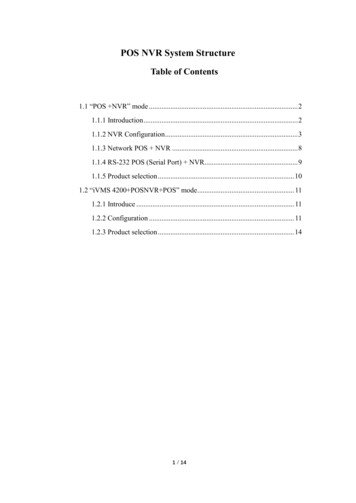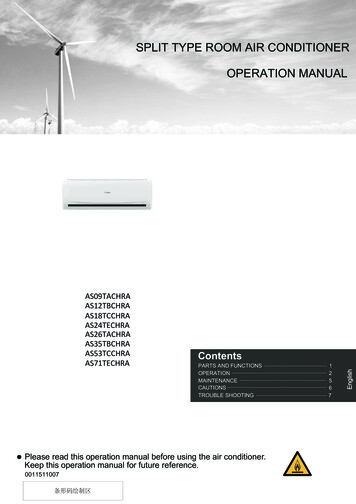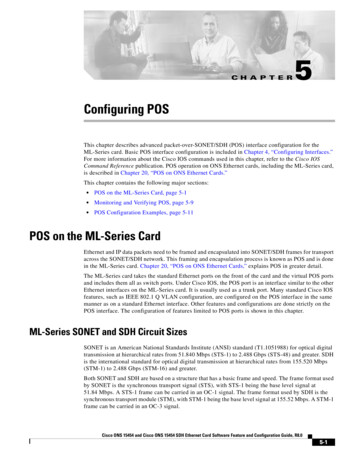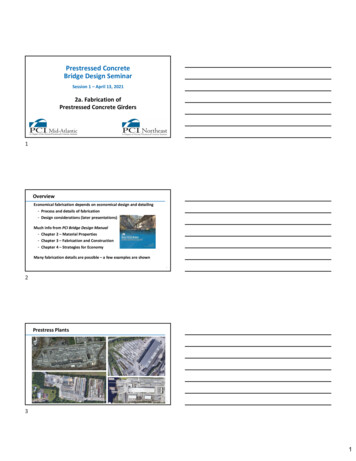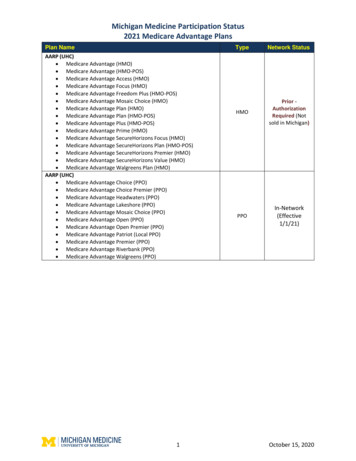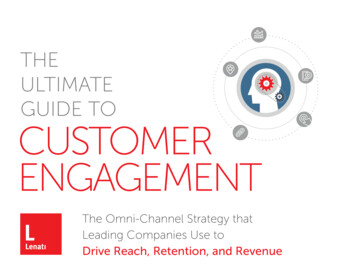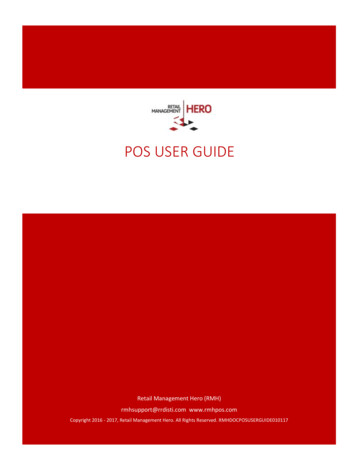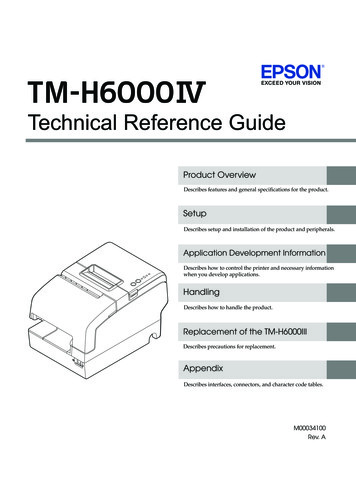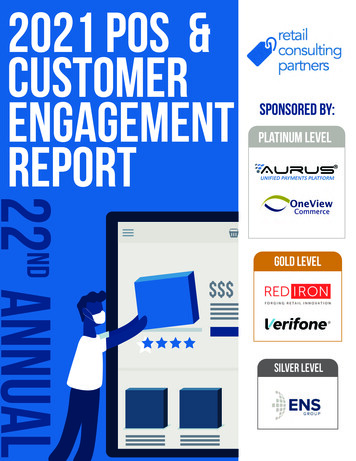
Transcription
22nd annual2021 POS &CustomerEngagementReportSponsored by:Platinum levelgold level Silver level
Looking forward to 2021The COVID-19 pandemic during 2020 forced retailers to pivot fromexis ng plans and completely revamp their processes and, in manycases, technology to adapt to new customer shopping habits that wereshaped by social distancing guidelines and temporary closures ofnon-essen al retail businesses.We all know we’re not out of the mess of the pandemic yet, but manyof us are op mis c about retail in 2021. One silver lining to the chaosof 2020 is that retailers are reminded of how quickly they can executeand deliver when presented with adversity.The pandemic has greatly accelerated trends such as digital commerce,online ordering for grocery and restaurants, buy online, pickup at store(BOPIS), buy online, pickup at curb (BOPAC), contactless payments andother omni-channel capabili es. As consumers adapted to newshopping behaviors, many of these will become long-term habits. Thepandemic also brought into laser focus what worked well and what isnot working for each retailer. Beyond the necessary reac ons andtac cal needs, 2020 was in some ways an opportunity to pause, assessand clearly define the path ahead for retail.Retail has always had winners and losers. For many who struggledduring 2020, much of their fate was already in mo on before thepandemic. Some who prospered, where others did not, were savvyretailers that already had good omni-channel processes and were ableto quickly pivot to adapt to new customer shopping behaviors andexpecta ons.Shopping behaviors and retail strategies will vary by segment andbrand, as there is never a one size fits all approach. Now is the me forretailers to dig deep, evaluate their brand and customer experiencevision, and strategically execute around the crucial role that the storewill play in the future.There is no going back and there is no return to “normal.” The reality isthat normal has never been a constant – it con nues to evolve. Wecon nue to live in a me of rapid accelera on of technology advancesand business and socio-economic disrup on that has rippled throughout our personal, social and professional lives and evolved ourshopping behaviors and habits.We welcome you to join us as we explore these themes and retailers’top priori es for 2021 and their specific plans for customer engagement, stores and in-store technology. Key Findings Business Priori es for 2021 Customer Engagement Priori es for 2021 POS Priori es for 2021 Current State of Store Technology Planned Replacement of Store Technology Moving the Store to the Cloud The Store Remains the Central Customer Experience Hub2What’sinside?456789101113Business Priori es for 2021Customer EngagementPriori es for 2021Top POS Priori es for 2021Current State of StoreTechnologyPlanned Replacement ofStore TechnologyMoving the Store tothe CloudThe Store Remains the CentralCustomer Experience HubConclusionSponsors
2021 POS & Customer Engagement Reportkey findings 202167%33%4Mobile POS52%3POSPriorities52%Addi onal CustomerDelivery/Pickup Op onsTop Business Priorities85% 67% 52%Grow/EnhanceDigital Commerce41%Customer Iden fica on/Personaliza on of /Capabili esImprove/Op mizeSupply ChainMoved or Moving to the CloudNote: Only 51% of retailers have or plan to move POS to the cloud.67%41%Business Intelligence/Enterprise Repor ngCustomer Mobile ExperienceAlignment (Mobile App/Website/Responsive Design)67%Workforce Management/Time & A endance63%33%Real- me Retail (Dissemina ng,Monitoring and Execu onU lizing Real- me Data Acrossall Channels)Inventory Management59%Order ManagementUnified Commerce374%152%Omni-channelCapabili es/Integra on, LikeBOPIS or BOPACPOS So wareUpgrade/ReplacementCustomerEngagement PrioritiesAdd/Enhance OMS Integra on/Real- me ProductVisibilityof retailers have or plan to implement a unifiedcommerce pla orm2
2021 POS & Customer Engagement ReportBusiness Priorities for 2021Digital commerce volume was off the charts in 2020, asconsumers simply didn’t have much choice. With manynon-essen al retail stores closed, or with long wait- mes toenter based on limited capacity guidelines in some states,consumers flocked to online and mobile ordering.Op mizing Digital CommerceAs we all know, almost any product can now be easilyordered online and digital commerce will con nue to accelerate. In 2020, e-commerce accounted for nearly 20% ofretail transac ons and it’s likely to reach 25% or more oftotal retail transac ons in the near future. It is not a bigsurprise that heading into 2021, 85% of retailers haveindicated digital commerce is their top business priority.Consumers’ accelerated online shipping behaviors in 2020increased retailers focus on digital commerce and exposedareas of opportunity to improve online capabili es,omni-channel fulfillment op ons and execu on, as well astechnical infrastructure and integra on.Enhancing the Customer ExperienceIt’s more than just about the transac ons, it’s about theholis c customer experience and their journey. Customerswant anywhere, any me accessibility when shopping andthe omnipresent digital experience will con nue to play alarger role, whether purchases happen online or in thestore. Therefore, digital transforma on must consider theen re customer journey, including in-store experiences. It’sencouraging to see that 67% of retailers indicate that thecustomer experience is one of their top business priori es in2021. Retail has always been highly compe ve with con nually increasing customer expecta ons, which makes anop mized brand experience the most important and dis nguishing characteris c that o en defines the success orfailure of a brand.Improving Supply Chain Visibility and ProcessesNot only did 2020 reveal a lot of digital and customer experience opportuni es, but it also exposed many supply chainvulnerabili es. Recognizing areas that need improvement,52% of retailers indicated supply chain improvements andop miza on was a top business priority in 2021. From theobvious out of stock scenarios to the increase in localin-store pickups, supply chain and op miza on of inventoryvisibility and placement has never been more cri cal.Op mizing Fulfillment ModelsWith a drama cally shi ing physical landscape, fromshutdowns, store closures, to malls diminishing or closing,it’s an even bigger challenge to determine the op mal mixof centralized DCs, regional fulfillment centers, dark stores,and of course physical retail loca ons. The math and scienceof that op miza on is not easy, let alone predic ng futureconsumer behaviors and con nued technology andbusiness model disrup ons. Agility and balance areparamount as the retail landscape con nues to rapidlytransform. Mee ng customers increased expecta ons forfast fulfillment profitably con nue to be the elusive HolyGrail of the last mile of delivery.Top Business Prioritiesfor 2021Grow/Enhance Digital Commerce85%Expand/Enhance Customer Experience67%Improve/Op mize Supply Chain52%Expand Channels/Partner Op ons26%Add Retail Loca ons26%Improve Store Labor Efficiency22%Store Remodeling15%Reduce Opera on Costs7%85% of Retailers sayGrowing/EnhancingDigital Commerce istheir top BusinessPriority. 54
2021 POS & Customer Engagement ReportCustomer Engagement Priorities for 2021The top Customer Engagement Priori es for 2021 are certainlyreflec ve of the impacts that COVID-19 had on the retail industry in 2020. As retailers rushed to adapt, and con nually refine,new processes and technology to respond to drama c shi s inconsumer shopping behaviors, 2021 will be a year of con nuedenhancements of these capabili es.Personaliza on Takes a Backseat to Flexible Fulfillment &Retail MobilityWhereas personaliza on of the shopping experience was a toppriority for the past couple of years, providing customers withflexible and convenient product fulfillment solu ons is now themost cri cal customer engagement priority heading into 2021.Impacted by store closures, limited shopper capacity, andoverall consumer fears around in-store shopping, retailers havebeen forced to accelerate many of their “buy anywhere, fulfillanywhere” objec ves from years past, and over half of oursurveyed retailers (52%) indicated this was their top priority for2021.Growth of BOPIS and BOPACRetailers who had not already invested in buy online, pickup instore (BOPIS) spent considerable me and effort in 2020scrambling to put those capabili es in place. Rushing to implement these omni-channel capabili es, in many cases, thesolu ons have been cobbled together. Retailers will need toexpend addi onal effort moving forward to ensure theseintegra ons and solu ons are op mized to minimize manualwork and opera onal support. In addi on, buy online, pickupat curb (BOPAC) become a much more common fulfillmentchoice for consumers in 2020 and con nues to be a keycapability of retailers seeking to minimize the brick-and-mortarrevenue impacts of COVID-19.Increased Focus on Mobile Solu onsRetailers implemen ng BOPIS and BOPAC capabili es andseeking to enhance those solu ons in 2021 have a strong focuson retail mobility. In the past, retailers’ customer mobileexperience alignment was focused on ensuring consistentmessaging, pricing and overall experience between the digitaland physical shopping environments. However, moving into2021, customer mobile experience alignment is all aboutbuilding features and func ons that allow a consumer tointeract with a brand’s physical loca on via their mobile deviceand 41% of retailers indicated this is a cri cal customer engagement priority for 2021.The Real-Time Retail Impera veWith customers ini a ng transac ons and purchasing productonline in record numbers, it’s impera ve that retailers solve theavailable-to-sell quandary that has plagued them in the pastand resulted in lost sales and abandoned carts. This is5evidenced by real- me retail coming in as the 4th most cri calcustomer engagement priority of 2021. Retail in real- mehelps deliver a vast swath of cri cal capabili es for today’smodern shopper: true product availability, order status, andconsistent pricing and promo ons across all sales channels.Real- me retail also extends to retail employees, as retailersare increasingly finding it important to ensure that their associates have access to the same amount of informa on as theircustomers in real- me via mobile devices on the sales floor.Empowering associates with the right mobile tools, makesthem much more knowledgeable and they can also be seen asvalue-added resources to shoppers by providing access tocustomer-specific shopping history and sugges ng customizedrecommenda ons and personalized offers.Self-service Op onsWe have seen a marked increase in self-service retail as a keypriority for 2021. No doubt buoyed by the pandemic impact in2020, consumers are increasingly desiring the ability toconsummate their transac ons in an associate-free process andretailers are responding in kind with increased investments inself-checkout lanes and self-service kiosks for product informa on and assistance.This has been aided by a notable shi to contactless paymentsand away from cash in many segments. This helped drive downthe cost of self-checkout by allowing retailers to avoid purchasing bill and coin accepter units in an increasing large percentage of their self-checkout units. In parallel, shi ing technologieshave now brought the cost of a credit only self-checkout unit tothe point it is comparable with a tradi onal POS device. We willcon nue to see the expansion of self-checkout and self-serviceinto new retail segments.Ever-increasing customer expecta ons, retail transparency andtoday’s anywhere, any me, anyhow shopping have put thecustomer experience center stage for most retailers. This retailtransparency also makes the retailer’s job more difficult as theycan no longer differen ate on just product or price, the customer experience itself has become the key differen ator that isdriving customer loyalty in 2021.52% of Retailers saythat additionalCustomerdelivery/pickupoptions is their topCustomerengagement Priority.
2021 POS & Customer Engagement ReportTop POS Priorities for 2021Top Customer Engagement Prioritiesfor 2021Addi onal Customer Delivery/Pickup52%Add/Enhance OMS Integra on67%Customer Iden fica on/Personaliza on41%Omni-Channel Capabili es/Integra on52%Customer Mobile Experience Alignment41%POS So ware Upgrade/Replacement52%Real- me Retail33%Mobile POS33%Empowering Associates with Mobile Tools33%POS Hardware Upgrade/Replacement30%Self-Service Op ons22%Add/Enhance CRM Capabili es30%COVID-19 Related PPE Func ons19%Unified or Single Payment Pla orm22%Customer-Facing Technology19%Payment Security/PCI Compliance15%Guided Selling/Clienteling15%Returns and Customer Feedback Op miza on11%Social Media Commerce/Analy cs11%Top POS Priorities for 2021With a con nued footprint of disparate legacy commerce technologies, many retailers con nue to struggle with efficient and profitableexecu on of omni-channel capabili es due to technical challenges.Retailers Priori ze OMS Integra onGiven the rise in digital transac ons, the urgency to deliverenterprise inventory visibility and orchestra on has increased, andso it comes as no surprise that 67% of retailers have order management system (OMS) integra on to their POS as their top priority in2021. Over me, OMS has risen as the key component and the“glue” that manages and coordinates omni-channel transac onorchestra on across all channels. OMS as a top priority makes sensegiven 52% of retailers’ second highest priority for POS is a focus onomni-channel capabili es.67% of Retailers say thatadding and enhancing OMSintegration is their top POSPriority.Con nuous Improvement of Omni-channel Capabili esAs 2020 played out, retailers scrambled to quickly deliveromni-channel features like BOPAC, which was much more difficult ifthey didn’t already have BOPIS in place. As previously men oned, alot of omni-channel fulfillment technology was a patchworkimplementa on at best and retailers know they need to make somestrategic decisions around future technology decisions to be ersupport their ever-evolving in-store and digital commerce needs.6The patchwork solu ons in place for many retailers, simply aren’tcost-effec ve, won’t scale and don’t fully deliver on customer expecta ons.POS Upgrades and ReplacementsPart of the strategic mix on retailers’ mind for 2021 is how toimprove their POS so ware. Up from 41% last year, 52% of retailershave indicated replacing their POS is a top priority in 2021. Asretailers think about a new POS system, it isn’t simply the transac onal siloed solu on of years past – it has to be a solu on that isintegral in delivering the overall omni-channel customer experience.2021 will s ll be a somewhat chao c year and some retailers will s llbe dealing with basic survival and adapta on, but we think mostretailers will be strongly considering their long-term plans forimproved commerce technology for all channels. We believe this willgreatly impact how retailers think about and posi on POS in thatoverall strategy. As retailers evaluate POS, many retailers are indicating a strong preference towards a common commerce pla orm orunified commerce approach, with 22% of retailers currently having acommon commerce pla orm today and over half of retailers (52%)indica ng they plan to implement in the next three years. Whileembracing the concept of cloud-based POS has been slow forretailers, we are seeing some significant trac on as 22% indicatetheir current POS is in the cloud and 29% of retailers indicate thattheir next POS will be in the cloud.A common commerce platform for store,mobile, and web (i.e. Unified Commerce)Implemented and Working Well11%Implemented but Needs Improvement11%Implement within 12 Months11%Implement within 3 Years41%No plans to Implement26%
2021 POS & Customer Engagement ReportCurrent State of Store TechnologyDuring the turbulent 2020 retail climate, most retailers triedto leverage exis ng in-store hardware and so ware toextend func onality and reduce expenses. Retailersacknowledge that the technology necessary to provide afast and easy sales transac ons is cri cal to keeping customers happy. However, with con nued economic uncertainty,many retailers appear to be pushing significant hardwareand so ware investments off un l 2022 or later.In 2018 and 2019, many retailers upgraded or added mobiledevices and POS hardware and in 2020 we saw the averageage of these devices increase. This indicates that only a verysmall percentage of retailers added any new mobile or fixedPOS devices in 2020. This was most noteworthy with only11% of POS hardware having an age of less than 2 years.Mobile capabili esAccording to the survey, for the 41% of the respondentsreported having mobile POS device, all of the devices havebeen in opera on for less than 5 years, which is consistentwith the findings from last year. The trends are similar formobile devices used for back office and customer engagement. The short ba ery life, the re rement of some mobileopera ng systems and the high impact nature of mobiledevice environments significantly contribute to the short lifespan of mobile POS devices. The lack of change in mobilePOS investments in 2020 was driven by the retailers ghtening their spending on mobile POS and shi ing their focus tocustomer-owned device-based solu ons. Addi onally,during the COVID-19 pandemic, mobile POS was seen bysome retailers as difficult to create “safe” transac ons withlack of shields and adequate distance between customersand employees.Addi onally, this year, we expected to see a large number ofmobile devices becoming outdated as they reach the end oflife of Microso CE opera ng systems (OS). This leads us tobelieve that many retailers, needed less mobile POS devicesin opera on, due to a lower number of customers, thesafety issues associated with line-bus ng and mobile checkout, and the risks of opera ng their mobile devices with theunsupported OS.Not surprisingly, one-third of retailers have back-officemobile hardware that is less than 2 years old. We saw li leto no growth in the number of retailers with back-officemobile devices, which indicates approximately 16% of retailers made significant investments in back-office mobilehardware last year. Prior to last year, there was a steadygrowth in retailers moving as many management func onsas possible to a mobile pla orm so they can be performedon the sales floor close to customers.7Retailers’ shi in focus to developing or op mizing BOPISand BOPAC capabili es in 2020 has pushed the purchase ofso ware and hardware for store management and non-selling produc vity tools further down the priority list. However, we are an cipa ng a notable upturn in spending in thearea of mobile devices for associates for back office andcustomer service func ons in 2021. A significant por on ofthis will be driven by retailers shi ing from rapidly implemented omni-channel opera ons to more hardened andautomated solu ons. This includes adding mobile devicefunc ons to enable a be er BOPIS and BOPAC experience.POS capabili esIt is interes ng to note that 41% of retailers are runningtradi onal fixed POS hardware that has been in opera onfor 5 years or longer. In significant contrast, no retailers havemobile POS hardware that is greater than 5 years old. Whilethe difference is significant, it is logical since mobile POS hasa shorter lifespan than POS terminals and o en do not havethe versa lity to adapt to a mul -func on pla orm forservicing consumers.It appears that slightly less than 10% of retailers eitherupgraded or replaced their POS so ware in 2020. Only 19%of retailers are using POS so ware that is less than 2 yearsold, which is down from 37% in last year’s survey. Readingbetween the lines it is safe to say that many retailersdeferred spending money on POS hardware or so wareupgrades or replacements in order to conserve cash flow orto focus on augmen ng exis ng func onality in 2020. Wean cipate this elongated spending cycle remaining constantas many retailers are looking to augment their core POS withomni-channel, mobile cloud-based, customer owned deviceso ware and tools as opposed to a total POS so warereplacement.As noted earlier in the survey, we expect a significantpor on of retailers’ 2021 technology spending to be focusedon integra ng or expanding a seamless integra on betweenPOS and order management capabili es which are thecenter of a true omni-channel, shop anywhere, any meexperience.11% of POShardware is lessthan 2 years old.
2021 POS & Customer Engagement ReportCurrent Technology Age 2 YearsPOS So warePOS HardwarePayment Sleds for MobileMobile Payment TerminalsMobile Devices - POSMobile Devices - Back-Office2 to 5 Years19%11%19%15%30%Planned replacement timeframe 12 Months 5 Years30%52%POS So ware30%26%44%22%37%41%11% 11%19%41%Payment Sleds for Mobile7%Mobile Payment Terminals15%11%33%7%15%30%4%26%30%Mobile Devices - POS26%Mobile Devices - Back-Office4%4%Mobile Devices - Customer Engagement30%30%Mobile Devices - Customer Engagement26%4% 15%22%Fixed Payment TerminalsFixed Payment Terminals19%41%41%Planned Replacement of Store TechnologyRetailers are looking to refresh their hardware and so ware with thelatest offerings to take advantage of versa lity and usability formul ple func ons.Increased Spending on POS Hardware and So wareA significant shi can be seen in the number of retailers that plan tobegin the process of replacing their POS hardware and so ware. Inthe next 12 months, 30% of retailers plan to replace their POSso ware which is an increase from last year when only 19% plannedupgrades or replacements in 12 months. Similarly, there is anincrease in planned POS hardware replacements, with 22% ofretailers planning to refresh their hardware in the next 12 months.Some of planned investments in POS projects were delayed from2020 to 2021 due to the pandemic. An addi onal contribu ng factorto the planned increase in POS investment is that many retailersrealized that their exis ng POS func onality was not easy to extendto support the large shi to omni-channel capabili es that wereaccelerated by the pandemic and new customer expecta ons.As retailers evaluate new POS op ons, they will look for newtechnology pla orms offering extensibility of the applica ons foromni-channel func ons, micro services-based architecture andlower cost of ownership. In the past, POS replacements where o endriven by the need to extend core POS func ons such as pricing orloyalty. While these func ons are now table stakes, interoperabilityand extensibility appear to be a bigger focus for POS upgrades.Mobile POS DevicesOf those companies that have mobile devices, 50% expect to replacetheir mobile POS terminals in the next three years. As notedpreviously, much of the mobile POS replacement will be driven byoutdated OS and the short life spans of mobile devices.8 3 YearsPOS Hardware48%15%1 to 3 Years4%30%48%48%30% of RetailersPlan to Replace POSSoftware in 2021.
2021 POS & Customer Engagement ReportMoving the Store to the CloudFor many retailers 2020 was focused on rapidly extendingthe func onality of their exis ng store opera ons applica on por olio. In many cases this required them to implement manual stop gap processes because their legacyso ware lacked architectural and func onal flexibilityand/or took too long to deploy. During the past five years,many retailers have realized the benefits of moving moreand more applica ons to the cloud, including faster deployment, enterprise visibility, ease of maintenance and lowertotal cost of ownership.The Cloud is the Future for Store Opera ons Func onsCloud technology con nues to make significant inroads formany applica ons that impact opera ons across the enterprise, influence employee produc vity and deliver improvedcustomer experiences. In nearly every major applica oncategory, over 50% of retailers reported that they are or willbe using cloud-based applica ons in the future. Currently,the applica ons that are most o en cloud-based are workforce management (48%), inventory management (44%),CRM (44%) and business intelligence and enterprise reporting (41%). The applica ons that are the most likely to moveto the cloud next are order management, loss preven onand pricing.Cloud-based POS is the FutureThere has been growth in the shi to cloud-based POSso ware, but it is s ll well below the tradi onal client-basedmoving the store to the cloudCloud Pla orm48%19%BI/Enterprise Repor ngTask Management26%44%19%26%26%Pricing33%26%CRMLoss Preven on41%37%Order Management33%Implemented & Working Well15%67%63%Implemented but Needs Improvement7%63%59%Implemented within 12 Months7%59%Implemented within 3 Years22%44%33%Special OrdersNo Plans to Implement41%22%Returns Processing9Cloud-Based POS Platform11%11%11%67%55%44%19%In addi on to the advantages of cloud-based POS notedabove, the ability to pay for cloud-based licenses that scaleswith usage vs. the large upfront tradi onal POS license isa rac ve to many retailers. The major inhibiter to adop onappears to be related to the uncertainty around the immaturity of some POS vendors architecture, scalability and thedelivery of true cloud architecture benefits.Plan to Move to CloudWorkforce ManagementInventory Managementso ware approach. Currently only 22% or retailers havecloud-based POS, however, another 29% plan to implementit in the next three years. Some of the slowness in adop onis driven by the wide differences in maturity of cloudtechnology in the POS market. While the adop on has beenslow, cloud-based POS will soon become the predominateapproach. There is already a significant set of infrastructureand opera onal experience applica ons used in the storethat are cloud-based which will con nue to encourage moreretailers to move POS, or at least major components of it, toa cloud-based pla orm.37%26%49%
2021 POS & Customer Engagement ReportThe Store Remains the CentralCustomer Experience HubRetail is s ll retail and it all comes back to the store. Whilee-commerce experienced accelerated growth in 2020,almost half of the me, customers selected to pick upe-commerce orders at the store. Customers have always hadgood reasons for selec ng local pickup of online orders –speed of access and avoiding shipping costs. With thepandemic, consumers had a new reason for choosing to pickup orders from the store – a chance get out of our homes. In2020, due to social distancing guidelines, the shi to working from home and less social and entertainment op ons,we all spent far more me at home than ever before. A tripto the store was a nice diversion from the never-endingZoom calls or Ne lix binging. While we love our homes andthe people we share them with, we also crave the outsideworld and the social interac ons and experiences that wejust can’t replicate while si ng at home or shopping online.Store Openings Planned for 2021The store remains the central focal point for many brandsand the central hub for customer experience. For someretailers, 2020 was all about survival and that con nues into2021, and for others it was a boom, as seen in segments likegrocery, DIY and home goods. Over half of the retailerssurveyed (56%), indicate they will open new stores in 2021.For some retailers, this is an ideal me to leverage great realestate opportuni es and poten ally relocate, experimentwith different formats or simply add new loca ons.Fulfillment Op onsAs retailers consider their supply chain and fulfillmentstrategies, it’s no surprise that many are considering regional fulfillment centers (48%) and dark stores (22%). While notappropriate for every brand, product or customer base,decentralized approaches to inventory can add somemuch-needed agility and cost effec veness to an ever morecomplex set of omni-channel order fulfillment and shoppingbehavior needs.56% of RetailersPlan to open storesin 2021.Future Growth PlansBrick and Mortar Stores56%Regional Fullfillment Centers48%Store-within-a-Store44%Pop-up Shops26%Dark Stores/Dedicated Online Fulfillment22%Special Event Hos ng/Venue19%Mall Kiosks11%Cafe/Restaurant/Bar7%Showrooms7%10OPEN
2021 POS & Customer Engagement ReportConclusionWe need to forget the concept of “normal,” as 2020 has reminded us that normal has always been an illusion. However, we all lookforward to celebra ng a return to more freedom of travel, mobility and social engagement. Which, of course, will mean a resurgence of more in-person shopping. The future retail winners see this as a me to assess and, if needed, reset key business strategies and their brand and customer experience promises for the future.The retail store will con nue to be the focal point for many brands, even as the u liza on of that space con nues to evolve andserve mul ple purposes. Shopping behaviors and customer expecta ons will con nue to rapidly evolve and retail technology hasto evolve to adapt to new paradigms. Technology strategies that focus on agility and adaptability are no longer just an insurancepolicy for an uncertain future but can be key differen ators for winning brands. Thinking about POS and other in-store technologydifferently is an impera ve. The customer experience of tomorrow is not the same as five years ago or even last year and, therefore, the concept of POS is and will be radically different than that of five years ago.Thank you for reading and, as always, we welcome your feedback from this ini al report of our 22nd Annual POS & CustomerEngagement Survey. This year we are releasing our POS & Customer Engagement Report as a mul -part series. Please join us as weexplore and expand on themes we touched on in this ini al report, through a series of special topic reports that cover the following: Mobile & Personaliza on Unified Commerce & Store of the Future Self-Service Payments & SecuritySurvey MethodologyCompany TypeSpecialty Hard GoodsThrough an online survey system, RCP conducted the 22nd AnnualPOS/Customer Engagement Surve
integra ons and solu ons are op mized to minimize manual work and opera onal support. In addi on, buy online, pickup at curb (BOPAC) become a much more common fulfillment choice for consumers in 2020 and con nues to be a key capability of retailers seeking to minimize the brick-and-mortar revenue impacts of COVID-19.
